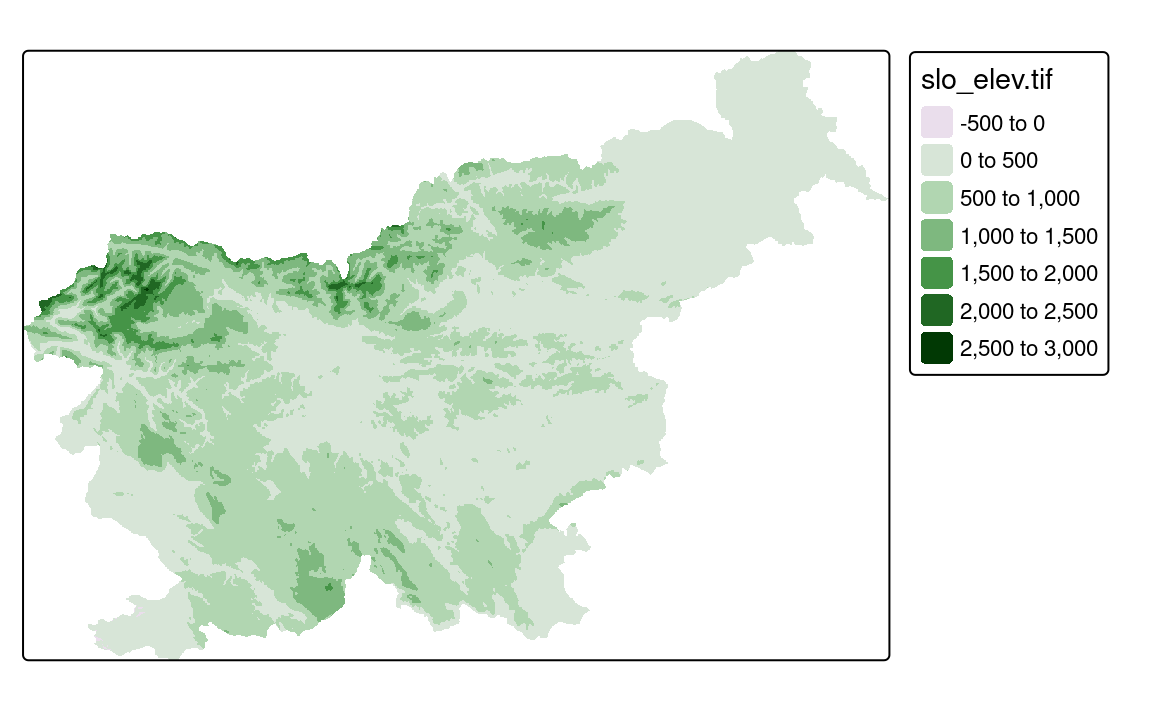9 Legends and titles
This chapter covers legends and titles in tmap – how to create, customize their appearance, and position them on the map. The examples in this chapter use the elevation raster data of Slovenia in meters above sea level (m asl).
9.1 Legends
Legends are an essential part of most maps. They provide meaning to the symbols or colors used in the map, and often add information about the map’s content. They allow for interpreting the map correctly, and are therefore crucial for the map’s readability.
In tmap, legends are created automatically when we add a layer with a data-driven visual variable. By default, such a legend consists of a title based on the variable name and a color/shape/symbol scale (Figure 9.1). It is placed outside of the map frame, either on the right or on the bottom of the map, depending on the automatically determined map aspect ratio.
Such a legend is helpful for quick exploration of the data, but often, they are not sufficient for sharing the map with others. This chapter covers how to customize the legend’s title, position, and appearance in tmap. Legends are also closely related to the visual variables and scales used in the map that were covered in chapters Chapter 7 and Chapter 8 – we recommend reading those chapters first. Legends are customized using the tm_legend() function that is passed to *.legend arguments of the layer functions, e.g., col.legend, shape.legend, size.legend, etc.
Often, the most significant part of the legend is the title. It informs the reader about the meaning of the colors or symbols used in the map, providing also additional context such as the unit of measurement. The title is set using the title argument of the tm_legend() function (Figure 9.2 (a)).
The legend title and its text can be customized in many ways, including changing its font size (title.size and text.size), font family (title.family and text.family), and font color (title.color and text.color). In some cases, the title is not needed, e.g., when the map is self-explanatory, and then this argument can be set to "". Another possibility, when only one legend is used, is to remove the legend title, but specify the map variable and its unit in the map title (Section 9.2).
By default, values in the legend are ordered from low to high (i.e., from top to bottom), but this can be reversed using the reverse argument (Figure 9.2 (b)).
In the Slovenia example, we have enough white space inside the map frame to fit the legend. You can do this by setting the position argument in tm_legend() (Figure 9.2 (c)) and using tm_pos_in() to define the legend’s location. The first two arguments of tm_pos_in() specify where inside the map frame the legend will appear (Chapter 11).

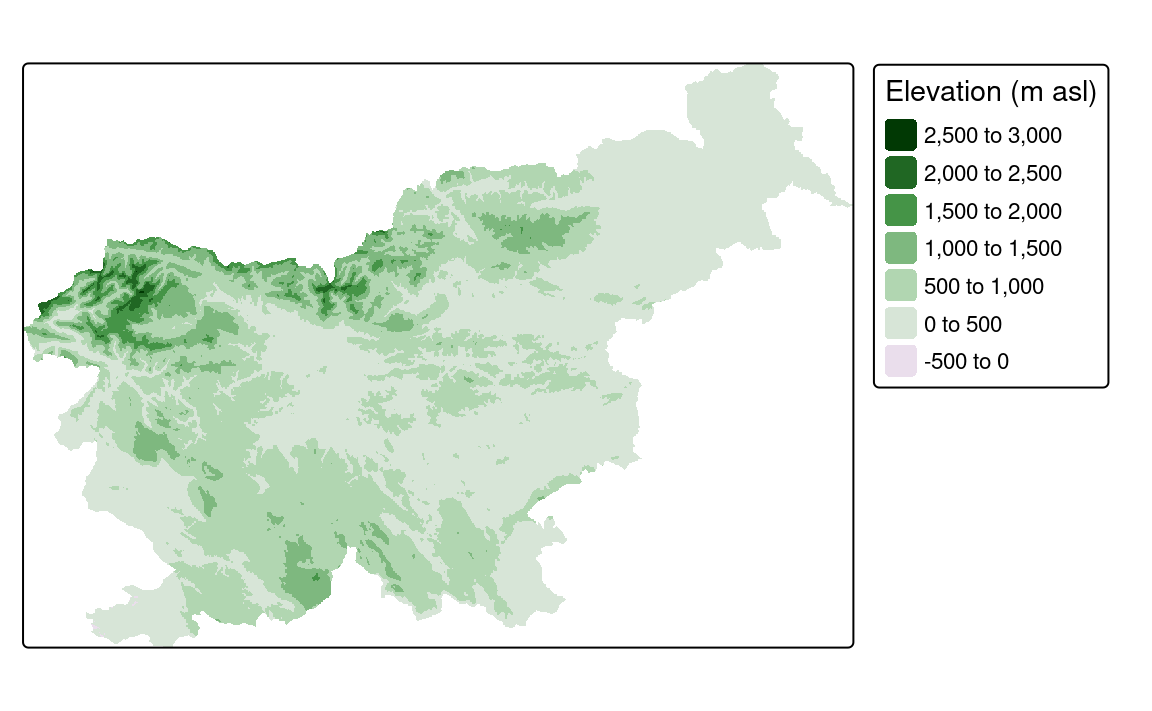
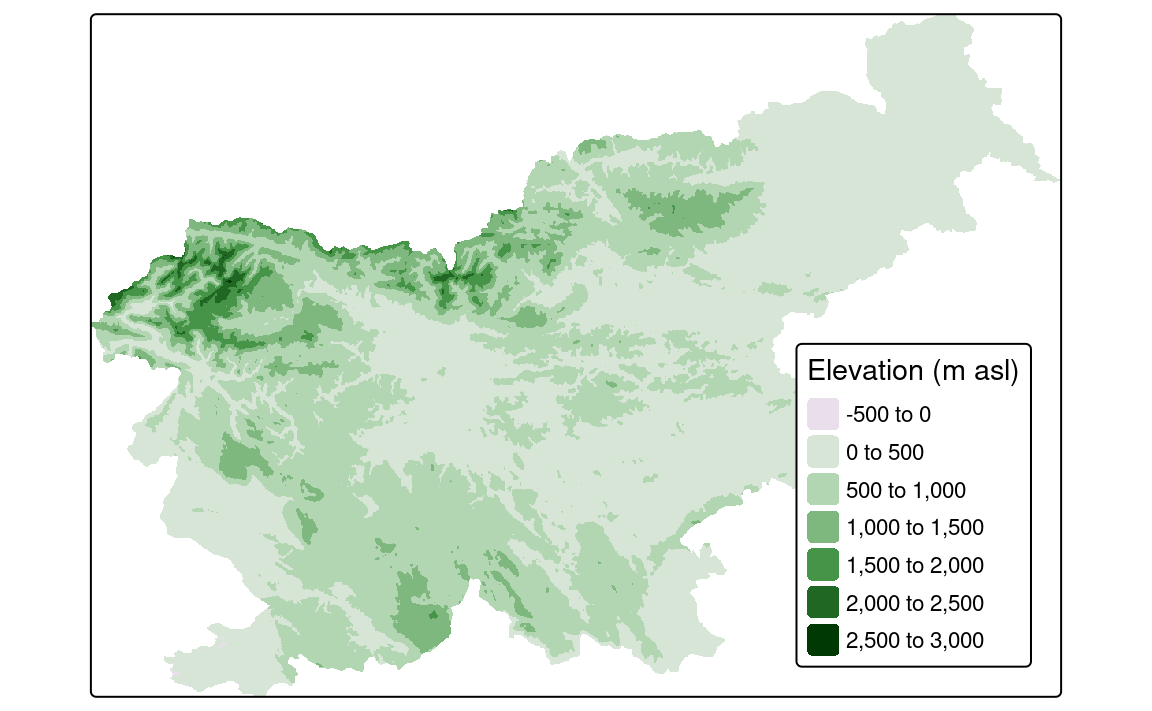
Depending on the map content, used colors, and expected aesthetic, the legend background can be colored or made transparent. The default legend background is white, but we may change it using the bg.color argument of the tm_legend() function. In the following example, we set the background color to gray and also make it semi-transparent using the bg.alpha argument (Figure 9.3 (a)).
All of the previous examples used the default legend orientation type called "portrait". Its alternative is "landscape", which can be set using the orientation argument of the tm_legend() function. This changes the legend layout to horizontal, which can be useful either to fit the map content better or to change the map aesthetic.
Here, we not only change the legend orientation, but also customize its position with tm_pos_out() (Chapter 11) 1. The three arguments used, "center", "top", and "center" specify the legend position in horizontal and vertical position outside the map frame, and then its position relative to that placement (Figure 9.3 (b)).
tm_shape(slo_elev) +
tm_raster(
col.legend = tm_legend(
title = "Elevation (m asl)",
orientation = "landscape",
position = tm_pos_out("center", "top", pos.h = "center")
)
)To disable the legend, we can set the show argument of the tm_legend() function to FALSE (Figure 9.3 (c)). This is useful when we want to use the same legend for multiple layers, or just when we are only interested in the map content and not in the legend – which may be the case when we are using the map for graphical purposes only.
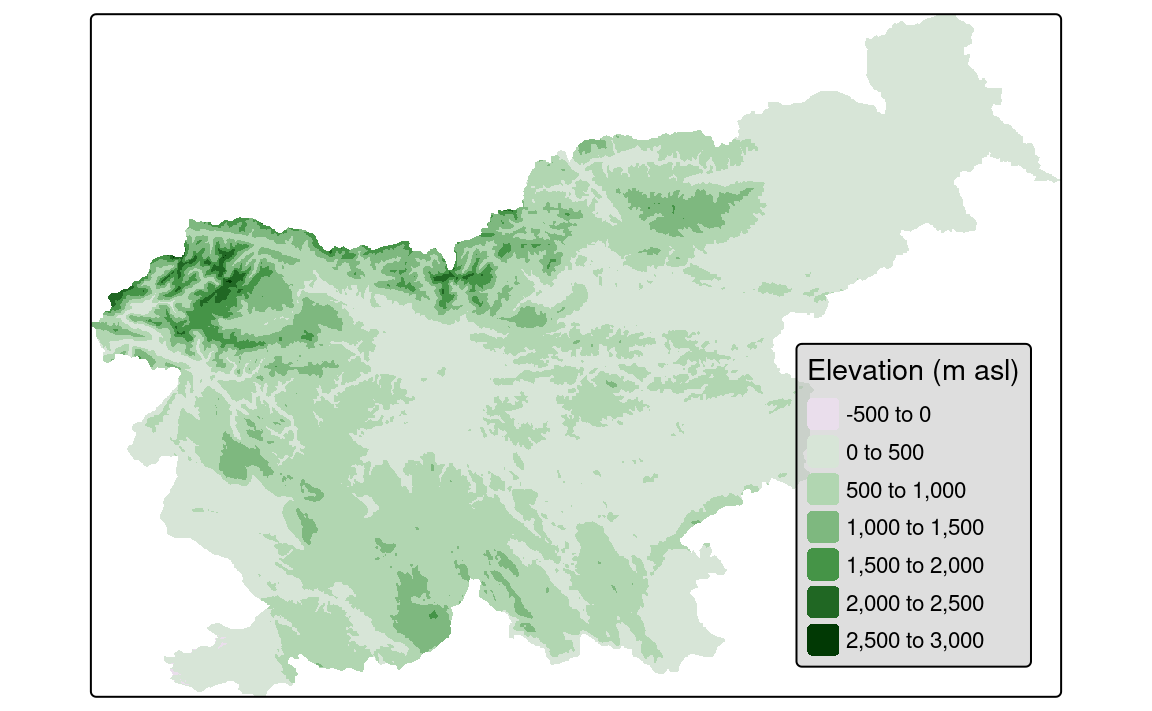
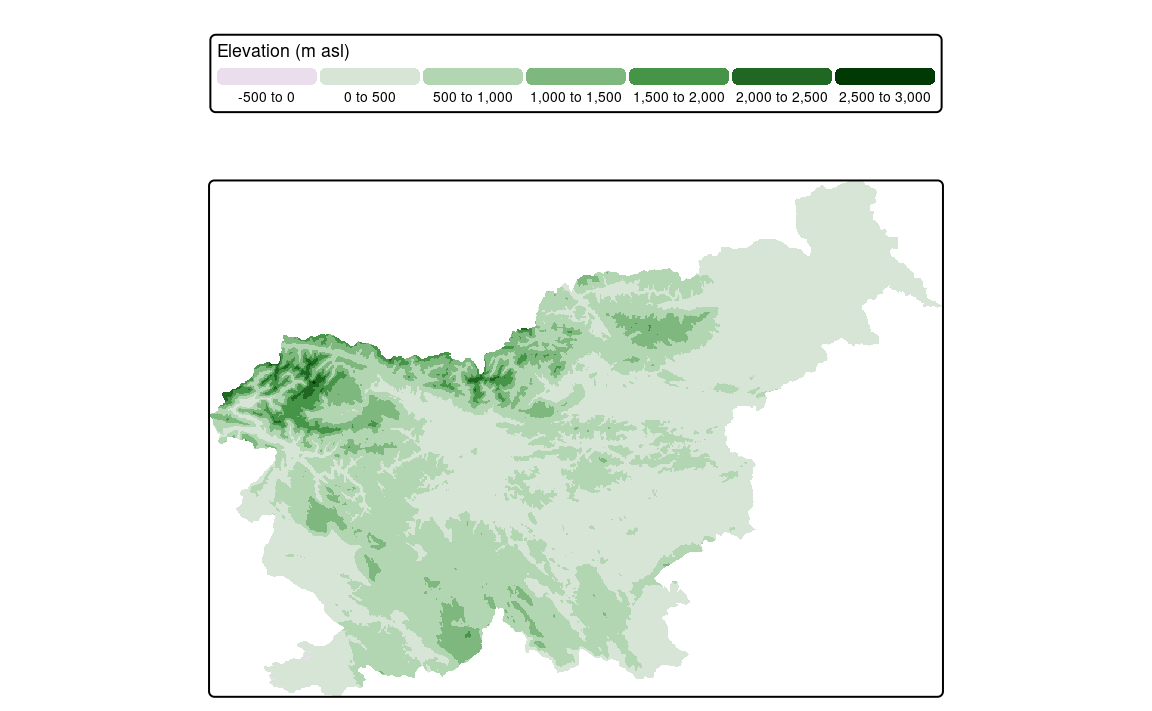
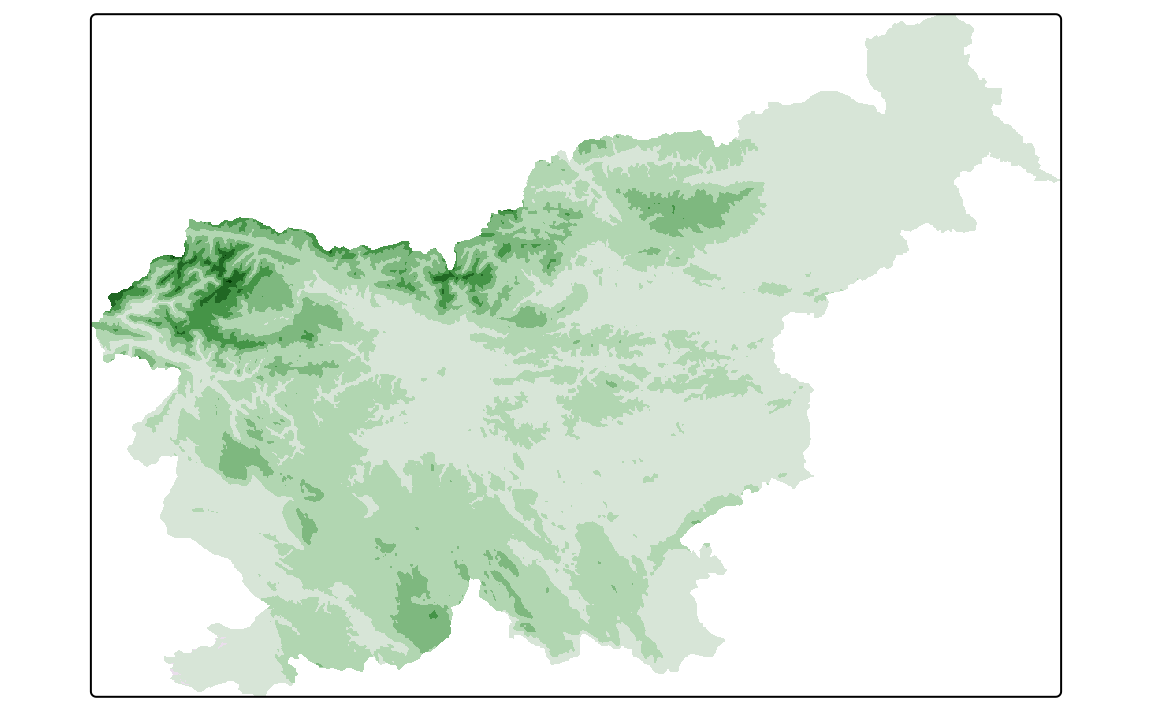
9.2 Titles
Titles are another essential part of the map, as they can provide context and information about the map content. In tmap, titles are added with the tm_title() function.
Titles could serve a few roles. They may provide a general description of the map content, such as the name of the area (Figure 9.4 (a)). Titles can also be used to replace the legend title (Figure 9.4 (b)) – then the reader can interpret the map content based on the title, which is more prominent than the legend title.

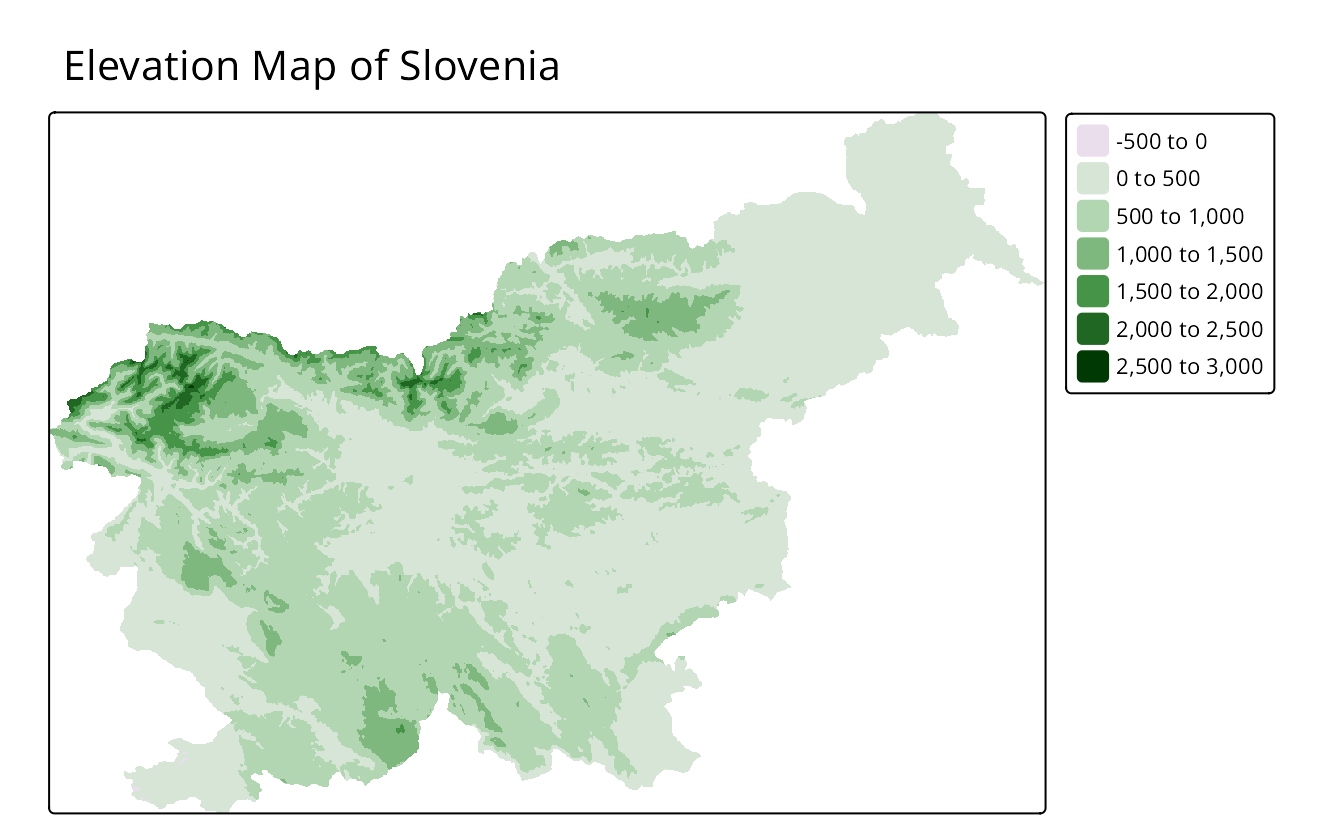
Titles are text elements and therefore can be customized in many ways, including changing the font size (size), font color (color), and font face (fontface) (Figure 9.5 (a)).
We can also add a background to the title, which can improve the visibility of the title text while providing a distinct aesthetic (Figure 9.5 (b)). A map title is treated as all of the rest of the map elements and, therefore, can be placed outside or inside of the map frame using the position argument of the tm_title() function (see Chapter 11 for more details).
tm_shape(slo_elev) +
tm_raster(col.legend = tm_legend(title = "")) +
tm_title("Elevation Map of Slovenia",
size = 1.5,
color = "white",
fontface = "bold",
bg = TRUE,
bg.color = "black",
position = tm_pos_out("center", "top", pos.h = "right")
)

Many titles can be used in the same map, e.g., a main title and a subtitle (Figure 9.6). This can be done by adding multiple tm_title() functions to the map, which is placed on the top left of the map by default, and tm_title_in() function to place the title inside the top left corner of the map frame.
A map can have multiple titles, such as a main title and a subtitle (Figure 9.6). You can add them by including tm_title() functions, which by default place titles at the top left outside the map. To position a title inside the top-left corner of the map frame instead, use the tm_title_in() function.
tm_shape(slo_elev) +
tm_raster(col.legend = tm_legend(title = "")) +
tm_title("Slovenia") +
tm_title_in("Elevation Map")
By default, the
"landscape"legend is located in the bottom right outside of the map frame↩︎
